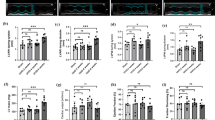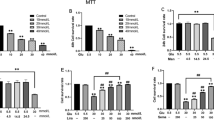Abstract
Nitric oxide (NO) is a potent pancreatic vasodilator, yet the pathogenic role of NO in acute pancreatitis remains controversial. NO is generated from L-arginine by NO synthase (NOS), classified into three isozymes: neuronal (nNOS), inducible (iNOS), and endothelial NOS (eNOS). The purpose of the present study was to investigate the role of NO/NOS isozymes in the pathogenesis of cerulein-induced acute pancreatitis in rats. Acute pancreatitis was induced in male Wistar rats by two subcutaneous injections of cerulein (20 μg/kg). N G-Nitro-L-arginine methyl ester (L-NAME: a nonselective NOS inhibitor) or aminoguanidine (a relatively selective iNOS inhibitor) was given orally, while tetrahydrobiopterin (BH4), a critical cofactor for NOS, was administered intraperitoneally 30 min before the first cerulein injection. Cerulein given repeatedly twice produced acute pancreatitis, with concomitant increases in the serum amylase level, pancreas weight, myeloperoxidase activity, lipid peroxidation and microvascular permeability. Prior administration of L-NAME, but not aminoguanidine, significantly prevented these changes, in a dose-dependent manner, and this effect was antagonized by the coadministration of L-arginine, a precursor of NO. The expression of dimetric eNOS in the pancreas was markedly suppressed by cerulein injections, together with a decrease in NO production, but the response was partially but significantly reversed by the prior administration of BH4. The increases in the serum amylase level and pancreas weight, as well as the lipid peroxidation induced by cerulein, were significantly attenuated by the administration of BH4. L-NAME had no effect on pancreatic secretion induced by cerulein. These results suggest that the uncoupled eNOS, probably caused by the decrease in endogenous BH4 availability, plays a deleterious role in the pathogenesis of cerulein-induced acute pancreatitis.




Similar content being viewed by others
References
Patel AG, Toyama MT, Nguyen TN, Cohen GA, Ignarro LJ, Reber HA, Ashley SW (1995) Role of nitric oxide in the relationship of pancreatic blood flow and exocrine secretion in cats. Gastroenterology 108:1215–1220
Palmer RMJ, Ashton DS, Moncada S (1988) Vascular endothelial cells synthase nitric oxide from L-arginine. Nature 333:664–665
Moncada S, Palmer RMJ, Higgs A (1991) Nitric oxide:physiology, pathophysiology, and pharmacology. Pharmacol Rev 43:109–142
Moncada S, Higgs A (1993) The L-arginine-nitric oxide pathway. N Engl J Med 329:2002–2012
Molero X, Guarner F, Salas A, Mourelle M, Puig V, Malagelada JR (1995) Nitric oxide modulates pancreatic basal secretion and response to cerulein in the rat: effects in acute pancreatitis. Gastroenterology 108:1855–1862
Liu X, Nakano I, Yamaguchi H, Ito T, Goto M, Koyanagi S, Kinjoh M, Nawata H (1995) Protective effect of nitric oxide on development of acute pancreatitisin rats. Dig Dis Sci 40:2162–2169
Werner J, Castillo FD, Rivera J, Kollias N, Lewandrowski KB, Rattner DW, Warshaw AL (1998) On the protective mechanism of nitric oxide in acute pancreatitis. Gut 43:401–407
DiMagno MJ, Williams JA, Hao Y, Ernst SA, Owyang C (2004) Endothelial nitric oxide synthase is protective in the initiation of cerulein-induced pancreatitis in mice. Am J Physiol 287:G80–G87
Weidenbach H, Lerch MM, Gress TM, Pfaff D, Turi S, Adler G (1995) Vasoactive mediators and the progression from oedematous to necrotizing experimental acute pancreatitis. Gut 37:434–440
Dabrowski A, Gabryelewicz A (1994) Nitric oxide contributes to multiorgan oxidative stress in acute experimental pancreatitis. Scand J Gastroenterol 29:943–948
Lomis TJ, Siffring CW, Chalasani S, Ziegler DW, Lentz KE, Stauffer KE, McMillan A, Agarwal N, Lowenstein CJ, Rhoads JEJr (1995) Nitric oxide synthase inhibitor N-monomethylarginine and aminoguanidine prevent the progressive and severe hypotension associated with a rat model of pancreatitis. Am Surg 61:7–10
Sugiyama Y, Kato S, Abe M, Mitsufuji S, Takeuchi K (2005) Different effects of dexamethasone and the nitric oxide synthase inhibitor on cerulein-induced rat acute pancreatitis. Inflammopharmacology (in press)
Ogawa K, Matsui H, Usui T (1992) Differential assay of human pancreatic and salivary alpha-amylases with p-nitrophenyl-65-o-beta-D-galacopyraosyl -alpha-maltopentaoside as the substrate. Biosci Biotech Biochem 56:1933–1936
Usui T, Ogawa K, Nagai H, Matsui H (1992) Enzymic synthesis of p-nitrophenyl 65-o-beta-D-galacopyraosyl-alpha-maltopentaoside as the subtrate for human alpha-amylases. Anal Biochem 202:61–67
Bradley PP, Priebat DA, Christensen RD, Rothstein G (1982) Measurement of cutaneous inflammation:estimation of neutrophil content with an enzyme marker. J Invest Dermatol 78:206–209
Katayama S, Shionoya H, Ohtake S (1978) A new method for extraction of extravasated dye in the skin and the influence of fasting stress on passive cutaneous anaphylaxis in guinea pigs and rats. Mcrobiol Immunol 22:89–101
Ohkawa H, Ohishi N, Yagi K (1979) Assay for lipid peroxides in animal tissues by thiobarbituric acid reaction. Anal Biochem 95:351–358
Green LC, Wagner DA, Glogowski J, Skipper PL, Wishnok JS, Tannenbaum SR (1982) Analysis of nitrate, nitrite, and [15N] nitrate in biological fluids. Anal Biochem 126:131–138
Venema RC, Ju H, Zou R, Ryan JW, Venema VJ (1997) Subunit interactions of endothelial nitric-oxide synthase. Comparison to the neuronal and inducible nitric-oxide synthase isoforms. J Biol Chem 272:1276–1282
Kakoki M, Hirata Y, Hayakawa H, Suzuki E, Nagata D, Tojo A, Nishimatsu H, Nakanishi N, Hattori Y, Kikuchi K, Nagano T, Omata M (2000) Effects of tetrahydrobiopterin of endothelial dysfunction in rats with ischemic acute renal failure. J Am Soc Nephrol 11:301–309
Cuzzocrea S, Mazzon E, Dugo L, Serraino I, Centorrino T, Ciccolo A, Van de Loo FA, Britti D, Caputi AP, Thiemermann C (2002) Inducible nitric oxide synthase-deficient mice exhibit resistance to the acute pancreatitis induced by cerulein. Shock 17:416–422
Qui B, Mei QB, Ma JJ, Korsten MA (2001) Susceptibility to cerulein-induced pancreatitis in inducible nitric oxide synthase-deficient mice. Pancreas 23:89–93
Vaquero E, Molero X, Puig-Divi V, Malagelada JR (1998) Contrasting effects of circulating nitric oxide and nitrergic transmission on exocrine pancreatic secretion in rats. Gut 43:684–691
Al-Mufti RA, Williamson RC, Mathine RT (1998) Increased nitric oxide activity in a rat model of acute pancreatitis. Gut 43:564–570
Landmesser U, Dikalov S, Price SR, McCann L, Fukai T, Holland SM, Mitch WE, Harrison DG (2003) Oxidation of tetrahydrobiopterin leads to uncoupling of endothelial cell nitric oxide synthase in hypertension. J Clin Invest 111:1201–1209
Oelze M, Mollnau H, Hoffmann N, Warnholtz A, Bodenschatz M, Smolenski A, Walter U, Skatchkov M, Meinertz T, Munzel T (2000) Vasodilator-stimulated phosphoprotein serine 239 phosphorylation as a sensitive monitor of defective nitric oxide/cGMP signaling and endothelial dysfunction. Circ Res 87:999–1005
Guzik TJ, Mussa S, Gastaldi D, Sadowski J, Ratnatunga C, Pillai R, Channon KM (2002) Mechanisms of increased vascular superoxide production in human diabetes mellitus; role of NAD(P)H oxidase and endothelial nitric oxide synthase. Circulation 105:1656–1662
Hink U, Li H, Mollnau H, Oelze M, Matheis E, Hartmann M, Skatchkov M, Thaiss F, Stahl RA, Warnholtz A, Meinertz T, Griendling K, Harrison DG, Forstermann U, Munzel T (2001) Mechanisms underlying endothelial dysfunction in diabetes mellitus. Circ Res 88:E14–E22
Satoh M, Fujimoto S, Haruna Y, Arakawa S, Horike H, Komai N, Sasaki T, Tsujioka K, Makino H, Kashihara N (2005) NAD(P)H oxidase and uncoupled nitric oxide synthase are major sources of glomerular superoxide in rats with experimental diabetic nephropathy. Am J Physiol 288:F1144–F1152
Acknowledgments
We sincerely express our gratitude to Mr. Akira Nanbu, Clinical Laboratory of Medicine, Kyoto Prefectural University of Medicine, for accurately measuring serum amylase levels.
Author information
Authors and Affiliations
Corresponding author
Rights and permissions
About this article
Cite this article
Sugiyama, Y., Kato, S., Mitsufuji, S. et al. Pathogenic Role of Endothelial Nitric Oxide Synthase (eNOS/NOS-III) in Cerulein-Induced Rat Acute Pancreatitis. Dig Dis Sci 51, 1396–1403 (2006). https://doi.org/10.1007/s10620-006-9125-1
Received:
Accepted:
Published:
Issue Date:
DOI: https://doi.org/10.1007/s10620-006-9125-1




